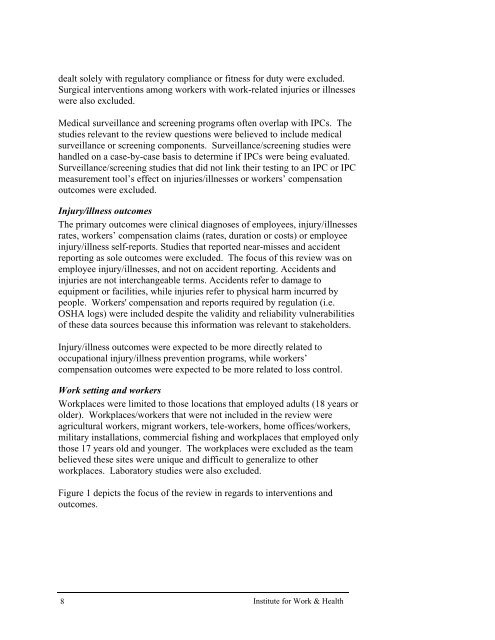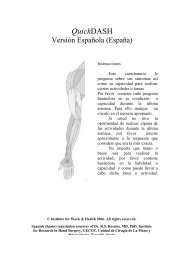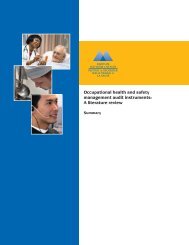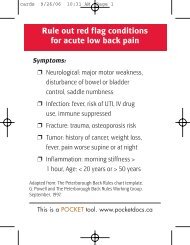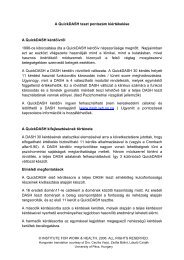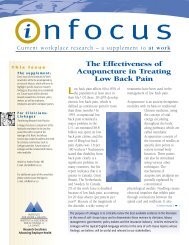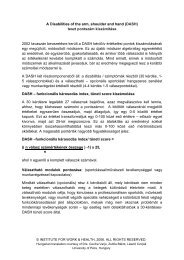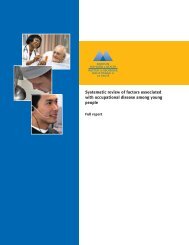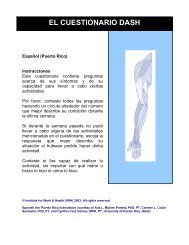A systematic review of injury/illness prevention and loss control ...
A systematic review of injury/illness prevention and loss control ...
A systematic review of injury/illness prevention and loss control ...
- No tags were found...
Create successful ePaper yourself
Turn your PDF publications into a flip-book with our unique Google optimized e-Paper software.
dealt solely with regulatory compliance or fitness for duty were excluded.Surgical interventions among workers with work-related injuries or <strong>illness</strong>eswere also excluded.Medical surveillance <strong>and</strong> screening programs <strong>of</strong>ten overlap with IPCs. Thestudies relevant to the <strong>review</strong> questions were believed to include medicalsurveillance or screening components. Surveillance/screening studies wereh<strong>and</strong>led on a case-by-case basis to determine if IPCs were being evaluated.Surveillance/screening studies that did not link their testing to an IPC or IPCmeasurement tool’s effect on injuries/<strong>illness</strong>es or workers’ compensationoutcomes were excluded.Injury/<strong>illness</strong> outcomesThe primary outcomes were clinical diagnoses <strong>of</strong> employees, <strong>injury</strong>/<strong>illness</strong>esrates, workers’ compensation claims (rates, duration or costs) or employee<strong>injury</strong>/<strong>illness</strong> self-reports. Studies that reported near-misses <strong>and</strong> accidentreporting as sole outcomes were excluded. The focus <strong>of</strong> this <strong>review</strong> was onemployee <strong>injury</strong>/<strong>illness</strong>es, <strong>and</strong> not on accident reporting. Accidents <strong>and</strong>injuries are not interchangeable terms. Accidents refer to damage toequipment or facilities, while injuries refer to physical harm incurred bypeople. Workers' compensation <strong>and</strong> reports required by regulation (i.e.OSHA logs) were included despite the validity <strong>and</strong> reliability vulnerabilities<strong>of</strong> these data sources because this information was relevant to stakeholders.Injury/<strong>illness</strong> outcomes were expected to be more directly related tooccupational <strong>injury</strong>/<strong>illness</strong> <strong>prevention</strong> programs, while workers’compensation outcomes were expected to be more related to <strong>loss</strong> <strong>control</strong>.Work setting <strong>and</strong> workersWorkplaces were limited to those locations that employed adults (18 years orolder). Workplaces/workers that were not included in the <strong>review</strong> wereagricultural workers, migrant workers, tele-workers, home <strong>of</strong>fices/workers,military installations, commercial fishing <strong>and</strong> workplaces that employed onlythose 17 years old <strong>and</strong> younger. The workplaces were excluded as the teambelieved these sites were unique <strong>and</strong> difficult to generalize to otherworkplaces. Laboratory studies were also excluded.Figure 1 depicts the focus <strong>of</strong> the <strong>review</strong> in regards to interventions <strong>and</strong>outcomes.8 Institute for Work & Health


